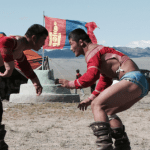 Technology
Technology  Technology
Technology  Humans
Humans 10 Everyday Human Behaviors That Are Actually Survival Instincts
 Animals
Animals 10 Animals That Humiliated and Harmed Historical Leaders
 History
History 10 Most Influential Protests in Modern History
 Creepy
Creepy 10 More Representations of Death from Myth, Legend, and Folktale
 Technology
Technology 10 Scientific Breakthroughs of 2025 That’ll Change Everything
 Our World
Our World 10 Ways Icelandic Culture Makes Other Countries Look Boring
 Misconceptions
Misconceptions 10 Common Misconceptions About the Victorian Era
 Mysteries
Mysteries 10 Strange Unexplained Mysteries of 2025
 Miscellaneous
Miscellaneous 10 of History’s Most Bell-Ringing Finishing Moves
 Technology
Technology Top 10 Everyday Tech Buzzwords That Hide a Darker Past
 Humans
Humans 10 Everyday Human Behaviors That Are Actually Survival Instincts
 Animals
Animals 10 Animals That Humiliated and Harmed Historical Leaders
Who's Behind Listverse?

Jamie Frater
Head Editor
Jamie founded Listverse due to an insatiable desire to share fascinating, obscure, and bizarre facts. He has been a guest speaker on numerous national radio and television stations and is a five time published author.
More About Us History
History 10 Most Influential Protests in Modern History
 Creepy
Creepy 10 More Representations of Death from Myth, Legend, and Folktale
 Technology
Technology 10 Scientific Breakthroughs of 2025 That’ll Change Everything
 Our World
Our World 10 Ways Icelandic Culture Makes Other Countries Look Boring
 Misconceptions
Misconceptions 10 Common Misconceptions About the Victorian Era
 Mysteries
Mysteries 10 Strange Unexplained Mysteries of 2025
 Miscellaneous
Miscellaneous 10 of History’s Most Bell-Ringing Finishing Moves
10 Formerly Controversial Olympic Sports That Became Mainstream
The Olympics are a showcase of the world’s athletic elite, bringing together the most respected sports from around the globe. Yet not every sport in the Olympics was welcomed with open arms when it first appeared. Some sports faced harsh criticism and skepticism, with detractors questioning whether they were “Olympic material.”
From worries about professionalism to doubts about physical rigor, each addition challenged the Olympic ideals and traditions in its own way. Here’s a look at ten Olympic sports that caused an uproar when they were introduced but ultimately found their place on the world stage, becoming iconic elements of the games.
Related: 10 Most Curious and Downright Insane Sporting Controversies
10 Basketball (Added in 1936)
Basketball’s addition to the Olympics in 1936 raised eyebrows among traditionalists who believed that team-based sports didn’t belong in the games. Up until then, the Olympics focused on individual achievements in events like track and field, gymnastics, and swimming, where athletes competed alone rather than as part of a team. Basketball, seen as a distinctly American pastime with its roots in Massachusetts, was met with skepticism by countries that doubted its international appeal. Its debut on an outdoor clay court in Berlin, where players struggled with rain-soaked surfaces, didn’t help its reputation as a professional sport for elite athletes.
Despite these obstacles, basketball’s popularity grew rapidly, with the Olympics helping to boost its global appeal. In the following decades, international basketball flourished, and the introduction of the “Dream Team” at the 1992 Barcelona Games, featuring NBA stars like Michael Jordan and Magic Johnson, cemented basketball as one of the most-watched Olympic sports. The inclusion of 3×3 basketball in 2020 further demonstrated the sport’s adaptability, proving that basketball, once a controversial addition, has become a staple loved by fans worldwide.[1]
9 Beach Volleyball (Added in 1996)
When beach volleyball debuted at the 1996 Atlanta Games, it was met with resistance from Olympic traditionalists who felt it was too “casual” for the prestigious event. Critics argued that beach volleyball’s laid-back, beachy image didn’t align with the Olympic spirit, which had traditionally focused on sports that emphasized endurance, skill, and mental discipline. The sport’s revealing uniforms, especially for women, added to the controversy, with detractors claiming they clashed with the formal, dignified image of the Olympics.
Over time, however, beach volleyball has proven itself as an exciting, competitive, and intensely athletic sport, consistently drawing large crowds and capturing the attention of audiences worldwide. Its fast-paced, high-energy matches showcase players’ skill and agility, and the beach setting has become a fan-favorite feature, offering a unique visual experience. Today, beach volleyball is celebrated for its global appeal and intense athleticism, proving that even a sport initially dismissed as “frivolous” can enrich the Olympic experience.[2]
8 Snowboarding (Added in 1998)
The inclusion of snowboarding in the 1998 Winter Olympics in Nagano, Japan, was a major departure from tradition, sparking intense debate. Snowboarding culture, with its roots in extreme sports and a strong influence from skateboarding, clashed with the more formal, disciplined world of skiing. Traditionalists argued that snowboarding didn’t uphold the “spirit” of the Winter Olympics, fearing that its association with countercultural elements would detract from the event’s prestige. The International Ski Federation (FIS), which initially resisted including snowboarding, eventually took on the sport under pressure but was hesitant to fully embrace it.
However, snowboarding’s debut added an element of youth and excitement to the Winter Games, attracting a new generation of fans and showcasing exhilarating events like the halfpipe and slopestyle. Snowboarding quickly became one of the most popular events, with competitors like Shaun White and Chloe Kim becoming household names. Today, snowboarding is viewed as an essential part of the Winter Olympics, celebrated for its daring tricks and unique culture that bring fresh energy to the games.[3]
7 Tennis (Reintroduced in 1988)
Tennis was initially part of the Olympics in 1896, but it was removed in 1924 due to disputes over amateurism, as many players turned professional. When it was reintroduced in 1988, critics argued that tennis already had prestigious tournaments like Wimbledon and the US Open, making its Olympic inclusion redundant. Additionally, some believed that professional players would overshadow amateurs, skewing the spirit of the games. Many questioned whether tennis stars would take Olympic medals as seriously as Grand Slam titles, doubting its lasting place in the games.
Despite the skepticism, tennis quickly integrated into the Olympic landscape, with players from all over the world, including top-ranked stars, competing for the chance to win a gold medal. Today, athletes like Serena Williams, Rafael Nadal, and Roger Federer regard their Olympic achievements as career highlights, and winning a medal is now a major accomplishment in the sport. The Olympics also brings tennis to a global audience, introducing the sport to fans who might not otherwise follow it.[4]
6 Golf (Added in 2016)
Golf’s addition to the Olympics in 2016 after more than a century’s absence was controversial, with many critics questioning its relevance and accessibility. Detractors argued that golf was an elitist sport enjoyed by a small segment of society and was out of touch with the Olympic emphasis on inclusivity and accessibility. Furthermore, some believed that major golf tournaments like The Masters, the U.S. Open, and the British Open already provided enough global exposure for the sport. The backlash grew when several high-profile players skipped the Olympics due to the Zika virus and other concerns.
However, golf’s Olympic return ultimately proved valuable, with players increasingly seeing the Olympic gold as an honor on par with winning a major. Countries with less established golf scenes were motivated to support young talent, making golf a more global sport. Today, Olympic golf is embraced as a chance for golfers to represent their countries and promote the sport’s growth, despite initial doubts about its place in the games.[5]
5 Rugby Sevens (Added in 2016)
Rugby Sevens made its debut at the 2016 Rio Olympics, reigniting debates over rugby’s place in the Olympics since its last appearance in 1924. Rugby’s history in the Olympics was marked by a violent clash between the French and American teams in 1924, leading critics to worry about the sport’s physical intensity and aggressive reputation. Additionally, traditionalists argued that the sport’s violent collisions and tough playstyle conflicted with the values of sportsmanship and fair play central to the Olympic Games.
Despite these concerns, rugby sevens introduced a high-octane, fast-paced version of the sport, with matches lasting just 14 minutes, ideal for capturing the attention of a wide audience. The format was a hit, and the intensity of the games brought new energy to the Olympics. Rugby sevens has since proven that even physically demanding sports can find a place at the Olympics, adding a thrilling element to the games.[6]
4 Rhythmic Gymnastics (Added in 1984)
When rhythmic gymnastics was introduced to the Olympics in 1984, it sparked debates over whether it belonged in the world’s most elite sporting competition. Critics saw rhythmic gymnastics as more performance art than a sport, arguing that it emphasized dance and flexibility over athletic rigor. Some claimed that rhythmic gymnastics was more suited to the stage than the Olympics, raising doubts about its legitimacy as an athletic competition on par with sports like track or swimming.
Over time, however, rhythmic gymnastics has proven its athletic and artistic merits with intricate routines that require extraordinary skill, timing, and coordination. The sport’s popularity has grown, especially in countries like Russia and Japan, where it’s celebrated for its beauty and difficulty. Today, rhythmic gymnastics has become a highlight of the Olympics, valued for its elegance and complexity.[7]
3 Freestyle Skiing (Added in 1992)
When freestyle skiing made its Olympic debut in 1992, it faced criticism for its perceived similarities to snowboarding, which had already generated controversy. Traditionalists worried that freestyle skiing, which includes aerials, moguls, and ski cross events, was too risky and outlandish for the Olympics. Its emphasis on tricks and high-speed maneuvers made some question whether it was truly an “Olympic” sport, clashing with the values associated with traditional skiing disciplines.
Despite these concerns, freestyle skiing quickly found an enthusiastic audience, captivating fans with its mix of artistry, skill, and high-stakes maneuvers. The sport’s popularity has only grown, with new events being added to showcase even more daring skills. Today, freestyle skiing is celebrated as a visually exciting and challenging addition to the Winter Olympics, redefining what it means to compete on the slopes.[8]
2 Table Tennis (Added in 1988)
When table tennis joined the Olympic lineup in 1988, it was initially viewed by some as more of a casual game than a sport fit for Olympic competition. Critics saw it as an informal activity associated with rec rooms rather than arenas, doubting its ability to match the intensity of other Olympic sports. The fast, technical nature of professional table tennis, however, quickly won over fans, with Asian countries like China leading the way in showing just how skilled players could become.
Today, table tennis is a major Olympic sport that attracts a passionate following, with players training for years to reach the top. The sport’s Olympic presence has also helped boost its popularity worldwide, encouraging development programs in countries that traditionally didn’t compete in the sport. What once seemed an unlikely addition has now become one of the most thrilling events at the Olympics.[9]
1 Skateboarding (Added in 2020)
When skateboarding was announced as an Olympic sport for Tokyo 2020, it sparked intense debate. Skateboarding’s roots in counterculture, individualism, and street style seemed at odds with the structured, competitive nature of the Olympics. Many feared that bringing skateboarding into the Olympics would force it to abandon its core values, transforming it from a free-spirited lifestyle into a regulated sport. Traditionalists argued that skateboarding was too unstructured to fit within the Olympic framework.
However, skateboarding’s Olympic debut turned out to be a massive success, drawing in younger audiences and injecting a sense of authenticity into the games. Skaters from around the world showcased their talent and creativity, performing tricks and stunts that captivated viewers and made skateboarding one of the highlights of Tokyo 2020. Skateboarding now holds a unique place in the Olympic lineup, embodying a modern, dynamic approach to sportsmanship.[10]








